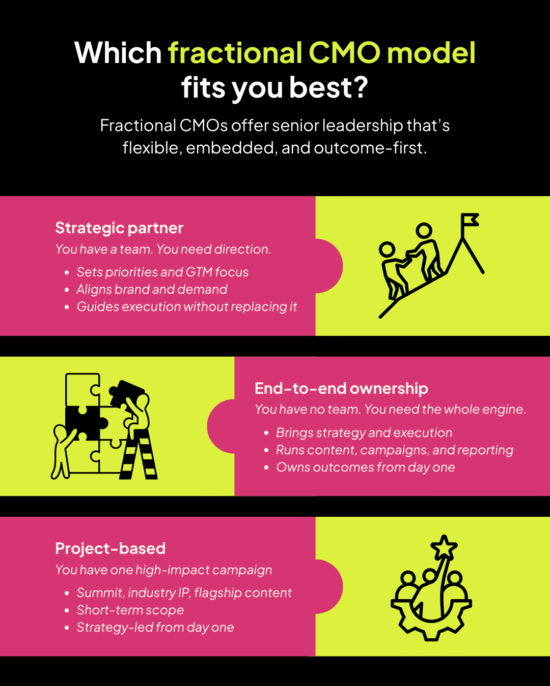Think of marketing leadership like an engine. When it runs well, strategy and execution move in sync, and growth feels like momentum. But without a strong driver, even the best-built parts can misfire, causing wasted effort, unclear direction, and uneven returns.
That’s the reality many early and mid-stage B2B brands face. You have activity. You have talent. You might even have an agency or two. But what’s often missing is a senior marketing leader who can connect the dots between brand, demand, and business outcomes.
Hiring a full-time CMO can feel like a big leap, especially when you’re still evolving your GTM, refining your ICP, or building traction.
What if you could access strategic clarity, execution oversight, and outcome accountability—without the cost or commitment of a full-time hire?
That’s where the Fractional CMO model comes in. And while it’s becoming a popular term, many still ask:
- What does a fractional CMO actually do?
- How are they different from consultants or agencies?
- When does this model make sense?
- And what does a real engagement look like?
At Tailwind, we’ve built, led, and scaled marketing for B2B brands across sectors. In this blog, we unpack the use cases, engagement models, and business value of the fractional CMO model—so you can decide if it’s the right fit for your growth journey.
What is a fractional CMO—really?
A Fractional CMO is a senior marketing leader who joins your team part-time but operates like a full-time owner. Unlike consultants who advise from the sidelines or agencies that focus on outputs, a fractional CMO integrates into your business to drive outcomes.
Engagement model of a fractional CMO explained
One of the most common questions we hear is: How does a fractional CMO actually work within a business? Is it an advisory role? Do they lead teams? How deep do they go?
The short answer: it depends on your setup. The real value of the fractional model lies in its flexibility.
At Tailwind, we typically see three types of engagement work best:
- Strategic partner model: This is ideal for companies that already have some marketing execution capacity in place—whether that’s an in-house team, freelancers, or an agency. What’s missing isn’t output, it’s orchestration. In this format, the fractional CMO acts as embedded leadership. They set priorities, shape strategy, mentor the team, and ensure that all efforts ladder up to business outcomes. The internal team executes; the CMO steers.
- End-to-end ownership model: This is better suited to companies that need full-stack marketing leadership and execution. Here, the fractional CMO doesn’t just guide the team—they bring the team. Strategy, content, campaigns, reporting—it’s all handled by one integrated function. For founders focused on product or sales, this model lifts the marketing weight entirely off their plate while still delivering at a high level.
- Project-based engagements: These work well for companies looking to build authority through a single marquee initiative, like an industry report, summit, or flagship content series. It’s a shorter-term commitment, but it still led with the same outcome-first mindset.
Across all models, the throughline is the same: Fractional doesn’t mean hands-off. It means right-sized leadership—deep enough to drive impact, flexible enough to adapt to your growth journey.
Where the model delivers: real-world use cases
Fractional CMOs bring structure, speed, and senior thinking to very different kinds of marketing problems. But how this plays out varies depending on the business stage, market complexity, and internal team capacity. Here are three common scenarios where this model creates a meaningful impact:
1. From scattered execution to strategic GTM focus
Early-stage companies often find themselves doing “a lot of marketing,” but struggling to connect it to outcomes. Channels are active, but campaigns don’t convert. Positioning feels vague. Content lacks direction.
In one such case, a fast-moving fintech startup needed help aligning their messaging with their ICP and building a go-to-market engine that could scale. As their fractional CMO, we stepped in to bring structure, defining the GTM plan, refining the message, and guiding the internal team on execution priorities. Read more about it here.
2. Scaling marketing without scaling chaos
As companies grow, marketing often becomes a patchwork of agencies, freelancers, and ad-hoc efforts. What’s missing is a clear strategy, consistent execution, and someone to own the outcomes.
3. Building brand authority through thought leadership IPs
Marketing isn’t just about leads—it’s also about positioning your brand as a credible voice in your category. For associations, platforms, and companies with flagship initiatives, this often means launching industry reports, summits, or recognition programs.
Final thoughts: Is a fractional CMO right for you?
Marketing leadership isn’t a luxury—it’s a growth lever.
The fractional CMO model bridges the gap between scattered activity and strategic impact. It offers high-caliber thinking, day-to-day leadership, and performance accountability—without long-term headcount commitments.
Ask yourself:
- Are we lacking strategic focus across marketing?
- Do we need a leader to unify brand and demand?
- Is now the right time to invest in a full-time hire?
If the answer to any of these is uncertain, a fractional model might be the right starting point.
Because the question isn’t whether you need marketing leadership. It’s whether you need it full-time or just fully effective.
Let’s talk about what that might look like for your team.









